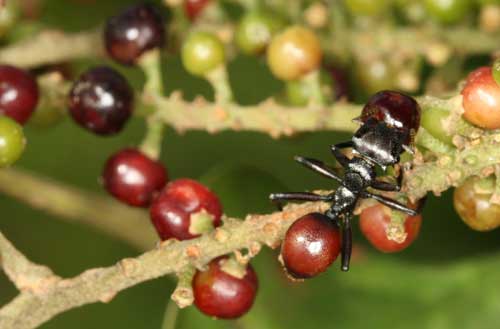Oh man, I love this shit.
Here's a vid of the fungal ant parasites in action :
http://www.youtube.com/watch?v=CCOQ0VU24xw
Allow me to dump some links and such, all under the heading
"Parasites that control/modify the behavior of their hosts":
-------------------
overviews of parasite manipulation of host behavior:
http://www.zoology.ufl.edu/bolker/eep/notes/week5.html
http://www.boloji.com/rt3/rt278.htm
http://www.boloji.com/rt3/rt279.htm
http://discovermagazine.com/2000/aug/co ... he%20world
Slideshow thingy:
http://discovermagazine.com/photos/04-z ... ntrol-them
----------------
Toxoplasmosis - parasitic protozoan that makes rats unafraid of cats,
and in the many many humans infected, it also seems to change hormone levels, sex ratio of offspring, psychology (infected men tend to score higher in paranoia, whereas for women toxoplasmosis seems to lead to higher levels of social trust and sexual promiscuity), and more ...
http://www.corante.com/loom/archives/20 ... asters.php
http://www.livescience.com/animals/0704 ... urine.html
http://www.bio.net/bionet/mm/parasite/2 ... 04385.html
http://human-infections.suite101.com/ar ... d_behavior
----------------
Zombie snails video:
http://www.youtube.com/watch?v=EWB_COSUXMw
------------
"The parasitic Nematomorph hairworm (Spinochordodes tellinii) develops inside land-dwelling grasshoppers and crickets until the time comes for the worm to transform into an aquatic adult. Somehow mature hairworms brainwash their hosts into behaving in way they never usually would – causing them to seek out and plunge into water."
- video
http://www.youtube.com/watch?v=xu9bqt2OgFM
- articles:
-
http://news.nationalgeographic.com/news ... asite.html
-
http://www.newscientist.com/article.ns?id=dn7927
----------------------
Ant parasite turns host into ripe red berry, biologists discover
http://berkeley.edu/news/media/releases ... ants.shtml

------------------
"life is certainly no beach when you’re a parasitic worm larva less than half a millimetre in length living on a murky lake bottom. Especially when, to reproduce, you face the Herculean task of making your way into a bird’s bloodstream ... the fluke first hitches a ride with a fish ... Once they have wormed their way into a rainbow trout’s bloodstream, the fluke larvae lodge themselves in their host’s eye, causing a cataract to form. The trout is then left to fumble around blindly, vulnerable to birds in search of their next meal. And while this already seems like a step towards success for the worm, its manipulating schemes don’t end here.
Rainbow trout are known to adapt their skin colour to blend in with their surroundings, with the amount of light entering their eyes determining how dark they become. When a parasite-induced cataract clouds their vision, the fish are seemingly fooled into thinking they are in a dark environment, and adjust their skin tone accordingly.
A parasitized trout consequently stands out like a sore thumb in light environments, making it an easy target for birds, and thereby allowing the fluke to complete its life cycle as it passes into the bird’s bloodstream."
link:
http://www.thenakedscientists.com/HTML/ ... parasites/
----------------
"in yellow dungflies, E. muscae directly manipulates host perching behaviour causing infected dungflies to perch abnormally in a highly specific manner. This new perching position, which involves changes in perching site, body posture and orientation on the plant, appears to be designed to meet the fungus's requirements for efficient spore dispersal and host infection."
http://www.jstor.org/pss/49995
----------------
"Consider the case of the thorny-headed worm, which spends its childhood growing in the belly of a pill bug, a small terrestrial crustacean that feeds on detritus and dry leaves and, occasionally, worm eggs scattered therein. But on reaching parasitic puberty, the worm requires a very different environment: an avian digestive tract. The worm wants the pill bug to be eaten by a bird. Fine: many birds will eat pill bugs if given the chance. But the worm has a tight schedule to keep, and it can’t afford to wait around and hope some industrious starling discovers its tasty crustacean housing. After all, a pill bug normally spends the sunlit hours when diurnal birds are about coiled away like a petite armadillo, often beneath some unpeckable tree stump or stone.
Through mechanisms that remain mysterious, then, the impatient parasite induces a precise sort of madness in its host. It prompts the poor creature to defy all known pill bug precautions, to venture forth in broad daylight and crawl onto a light-colored surface, where the dark pill bug stands out so starkly it might as well flash a sign saying, Snack Time! As a result, infected pill bugs end up being eaten by birds at a far higher rate than are their unparasitized peers, and the thorn-headed worm lives on. "
from good article:
http://www.nytimes.com/2007/06/26/scien ... ref=slogin
--------------
This is one of my favorites:
http://www.amnation.com/vfr/archives/010306.html
... multiple host life cycles w/ taking over of ant nervous systems to make them climb up and clamp onto the top of grass blades to find their way into the sheep they need to reproduce ...




